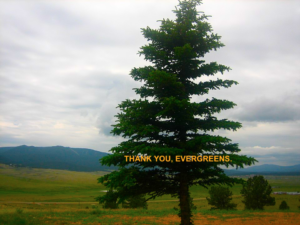Table of Contents
What do content marketers dream about? There’s a two-word answer: evergreen content. It’s that perfect, long-form content on an important industry topic that draws tons of organic traffic month after month. It brings new visitors, drives conversions, attracts natural backlinks, and performs overall as a treasured content asset that provides real value to readers.
Many content marketers find this perfect piece of content elusive, like a dream you can’t quite remember — or a perfect pair of jeans. Instead, they look for the hot new trending topic, and then have to find a new topic when traffic fizzles after a couple of months.
Don’t get us wrong: Covering trending topics is an important part of staying “cool” and relevant in any competitive search field. But it’s the perpetually popular and useful topics that should form the foundation of your content strategy.
Enter evergreen content. If you’ve never heard of evergreen content or aren’t sure what exactly it entails, you’re in luck: This post is here to introduce you to its wonders.
We’ll cover what evergreen content is, how to find good evergreen topics, and every different format evergreen content can take.
We’ve even included examples of some of our favorite examples in different niches to help you understand just what evergreen content can do for your content marketing strategy.
What Is Evergreen Content?
We’ll keep it simple: Evergreen content is relevant to your readers not just today, not just tomorrow, but for the foreseeable future, regardless of Christmas or Halloween or Beyoncé dropping a new secret album.
There are a few factors involved when you’re considering the long-term appeal of a topic, so keep these in mind:
Permanence, no. Longevity, yes!
A key point to remember is that content does not have to be relevant forever in order to be evergreen. No content will be permanently evergreen because technology, cultural norms, and nearly everything about the way we live, work, and play changes over time.
For example, a video about how to drive a car might be considered evergreen content last year and now, but as semi-autonomous vehicles become more prevalent, that video may lose its relevance.
A perfect example of evergreen content that has lost its relevance is this piece about how to talk on the telephone:
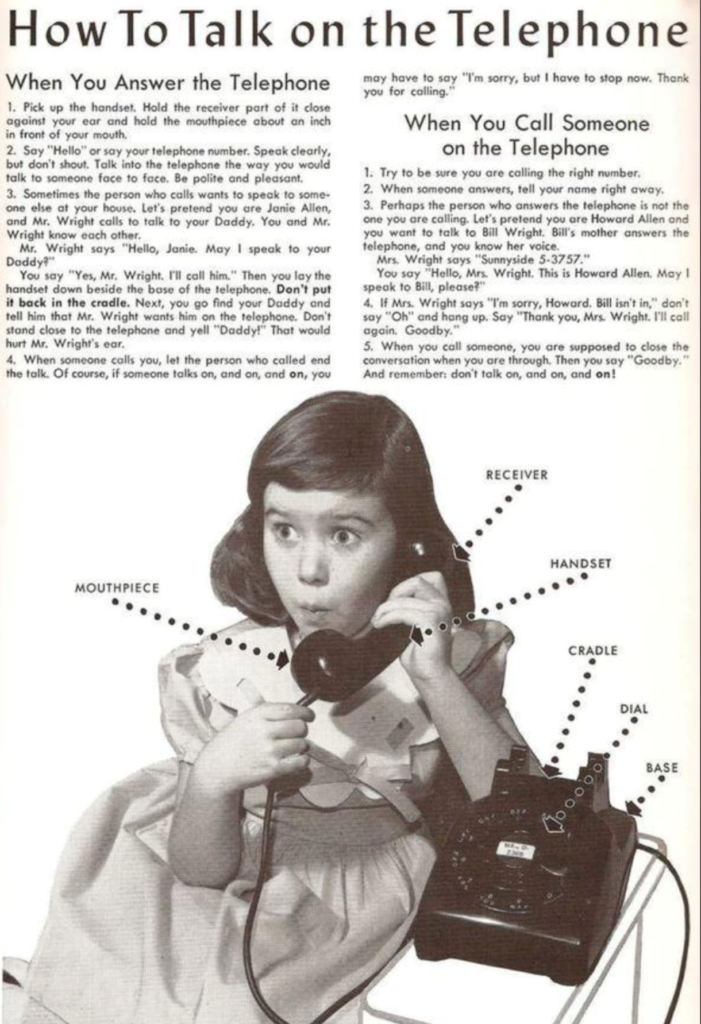
Nearly everything about this piece is now obsolete, and research on the term “how to talk on the telephone” yields a monthly search volume of 0-10:
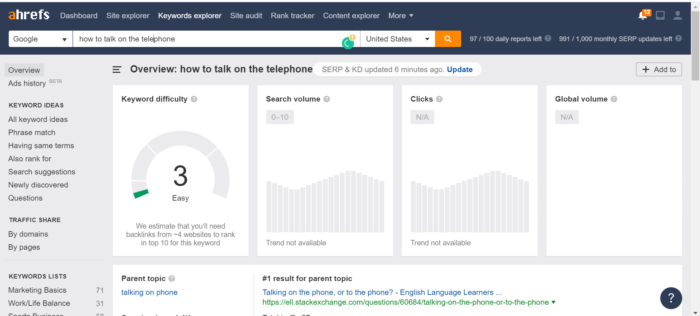
We don’t know how many people would have searched for that term when people were first learning how to use the telephone (Hint: because the internet didn’t exist yet), but it’s a safe bet that the number would have been much higher than 10.
Because technological and cultural change is inevitable, you don’t need to waste your time trying to find a perfectly and permanently evergreen topic. (You won’t find it.)
However! You can — and should — focus on content that will consistently build organic traffic for the foreseeable future. (Hopefully, you have the gift of seeing a little farther than the average person.)
Updating for continued relevance
Another key misunderstanding is interpreting evergreen content to mean that it never has to be updated once it’s written. This is not the case!
Evergreen content is not a “one and done” deal. Even if your topic remains perfectly evergreen for years, you’ll still want to update here and there to maintain high content quality and relevance so the material continues to bring in organic traffic.
Getting a page to rank for a high-value term doesn’t mean you will always rank for it, so regularly updating can help maintain your ranking. The telephone example above could be modified to use modern key-phrases and updated information to keep that content relevant to today’s readers.
Why Create Evergreen Content?
Evergreen content is consistently relevant to a large number of people searching in your niche.
A good evergreen topic will yield thousands of searches not just this month, but also a similar number of searches next month, and the next, for months and months to come.
It stays steady and draws consistent traffic among the ongoing barrage of viral news items, seasonal trends, and fleeting interests that entice your readers and bring short-lived spikes of organic traffic.
The strongest content marketing strategies mix evergreen content with trending topics.
The evergreen content establishes a foundation for your strategy, proving you’re an authority in your niche. Trending topics demonstrate your relevance. Visitors want to know you’re a long-term expert who’s also paying attention to the latest news.
A consistent stream of evergreen topics starts to have a compounding effect on your web traffic, letting organic traffic grow underneath the spikes of trending traffic.
Evergreen content takes a bit of effort to create, as we’ll see in the next few sections, but the returns you’ll get from investing those resources are well worth the work you’ll put in.
Different Types of Evergreen Content
Anyone can write a thousand-word blog post, so evergreen content must be more extensive and deeper than that. It takes a thorough and detailed piece of content to satisfy the keyword requirements well enough to rank and drive significant organic traffic on the broad topics used in evergreen content.
In this section, we’ll explore some common formats for evergreen content to help inspire your strategy—everything from a stellar longform blog to an interactive calculator.
But remember: You can’t just paint a tree green in the winter and call it an evergreen! (Unless you’re Bob Ross.)

While several formats lend themselves well to evergreen content, it’s important to remember that the topic itself must be evergreen. Using one of these formats with a non-evergreen topic will not make it more evergreen. The topic must have inherent, lasting appeal.
Informational Content
The broadest evergreen content type, informational content is most compatible with a long-form blog post. It provides a detailed look at the topic and focuses on educating the reader.
Informational content can follow a traditional blog post format, or it can take the form of one of these other types of content.
“What Is” Content
This is likely one of the most basic forms of evergreen, informational content, but can still be complex.
“What is” content simply answers the question, “What is this thing?” That’s obvious — and seems simple. But to make it a truly valuable resource for the reader, your content has to provide comprehensive information about every possible aspect of that thing.
This could include:
- Definitions of the term and concepts closely related to it
- Examples of this thing in action
- Classifications of different types of the thing
- Developments that have made this thing evolve over time
- Issues, problems, and solutions historically centered around the thing
- Interactions this thing has had with other things that make it important
- Additional resources available about the thing
“How To” Content
From changing spark plugs to applying white eyeliner to calibrating your social media analytics, “How to” content provides step-by-step instruction on accomplishing a specific task.
It can (and should!) include at least one of the following:
- Video of the full process
- Graphics or images demonstrating each step
- Possible highlights of issues for troubleshooting
- A list of supplies or tools, if relevant
The trick with this content is to find a topic that’s broad enough to be evergreen, but specific enough to provide actionable steps that readers can immediately take.
“History of” Content
A historical topic might sound a little dry and boring — and if you just write a text-only dissertation on the topic, it definitely will be. So don’t do that. Think visually. And personally.

Histories of a topic can take a variety of different formats, making it potentially one of the most fun types of content when done right. Interactive timelines, infographics, and historical imagery can bring not just organic traffic, but even an element of virality for the right topic.
In providing historical context for a topic, histories should trace the evolution of a concept and highlight key developments, eras or milestones. If it’s relevant, it can also be interesting to include moments from the personal history of a key player, as it relates to their role in the topic. (Haven’t you always wanted to know what propelled Thomas Crapper from simple 19th-century plumber to the sanitation-equipment mogul whose name we still remember today?)
Histories also can be gold mines for linking to related topics and external resources. And they offer the benefit of being easy to update. The past won’t be rewritten, so all you have to do to keep this content fresh is to add new milestones as they occur.
“Ultimate Guide” Content
A very popular format for evergreen content, ultimate guides are like your best friend on a topic: They know a little bit about everything topical, and if they don’t know something, they know where to find it. And they’ll tell all.
Ultimate guides bring together elements of every other kind of informational content. A guide should include definitions, history, and actionable tips for a topic. The best guides also include tools or resources that readers can use for further reading and learning.
Lists
Lists are popular because they’re so easy to digest (just like avocados!). Readers can skim, picking up just the bullet points, or they can stop and find the most relevant and useful information while getting additional context on what interests them most. Lists also can be bookmarked and referred to as needed by the reader.
Formatting content as a list can help you appear in featured snippets in search results, such as in the example below:
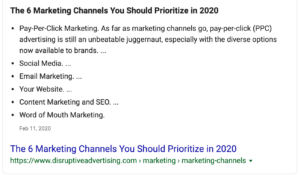
If a searcher just wants bullet points, snagging the featured-snippet spot isn’t going to earn you their click. But for everyone who wants a little more information, you’re guaranteed a huge percentage of that organic traffic for your ranking terms.
But you can’t make a list out of just anything. Here are some types of lists that work best for evergreen content:
-
Ideas
Since you can have ideas about pretty much anything, a list of them will be almost universally evergreen. Any industry can generate a list of ideas, whether it’s for content, ingredients, events, home improvements, or custom dog costumes.
Ideas will inspire your readers to start a project or tackle a problem. A list of ideas gives that last little push that makes them think, “Oh, I can do this! I should do this!”
A bonus: Long lists of ideas, with dozens or even hundreds of entries, can become bookmarked references that visitors will return to over and over again for more inspiration, and others in your niche may link to. That translates to consistent, steady traffic to your site.
-
Examples
Sometimes people best understand an idea by seeing it in action. Curating a list of examples of your topic in action can be a simple but effective way to inspire your readers while building connections in your niche — you might get additional backlinks or social shares, furthering the reach of your piece.
Like idea lists, example lists can also serve as references. The more examples, the more useful and evergreen your list will be.
-
Tips, Tricks, and Hacks
There’s a lot of competition for lists of tricks and hacks, so don’t make another one unless you’re sure you have tricks that no one has ever seen before. (And, um, they have to work.)
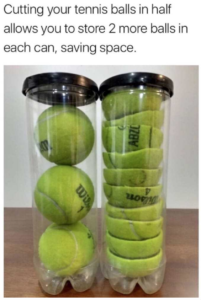
But if you can curate a list of tricks that gives every reader at least one new, surprising way to be more efficient and productive, you will see it pay off big-time.
TIP: Try not to compile a series of tips that build on each other; if a reader chooses not to try an early tip, that means all the subsequent ones are out, too. Each entry in this kind of list should be a standalone tip that readers can choose to use or ignore as they see fit.
-
Checklists
When we make a checklist — whether it’s a packing list or grocery list of items to assemble or a list of sequential steps for a complex project — we almost always forget something. Spare your readers the pain of forgetting by making a complete and comprehensive checklist for them. You can build a lot of goodwill by assuring them that someone else has thought of everything.
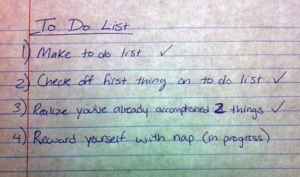
A checklist is a perfect candidate for conversion into a printable or interactive tool, allowing visitors to easily consult and put the list in action. The easier you make it for your visitors to take action, the more value your content offers — and you’ll see the rewards in your traffic stats.
Resources
If you have the content-creation resources (aka “smart enough writers with enough time in their schedules”) to develop a reference or resource on a topic, it will do wonders for your evergreen content strategy.
Now, when we say “resource,” we mean something good. It has to be more than just written text. It even has to be more than a high-quality video or infographic. A good resource provides truly unique and valuable information in a complete, compelling, and useful way.
If you can pull this off, not only will you get traffic from people seeking the information, but you’ll also see an increase in links to your site from people who are using your resource.
Here are some kinds of evergreen resources you can develop:
Templates
Imagine describing over someone’s shoulder how to write a resumé for the first time. Yeeesh. (Frustrating for everyone involved, right? Nobody’s getting that job!) Now imagine giving them a formatted template they can populate with their own information. Seems actually doable now, right?
Instead of telling visitors how to start a project, show them how with a template that provides a framework to jumpstart the project for them.
Templates must be broad and flexible enough to be both evergreen and adaptable. Don’t pigeonhole anyone into a path for the project, but give them freedom to make it their own. Some impressive results have evolved from plugging information into a template, then expanding and customizing from there.
TIP: From a content creation standpoint, templates can be made with really simple tools. Think about what software you most commonly and easily work in. If you’re like most people, you just want a link to a Google Doc or a downloadable PDF. That’s all your readers are looking for, too.
Tools
Almost anyone can write a blog post, but not everyone can build an interactive tool. If you can, you’ve got a slam-dunk way to enhance content that your competitors likely don’t have.
Interactive tools should be both eye-catching and useful, something that readers will bookmark for themselves and recommend to others.
Some tools may analyze content or web pages, provide virtual or augmented reality visuals, or allow users to build or choose something for their home or wardrobe. Others may, I don’t know, locate the nearest ice cream shop based on your ZIP code.
The only limit is your imagination (and maybe your coding resources).
Calculators
A subset of tools, calculators are often on the simpler side to create, but also are extremely valuable to users (and, therefore, to your content strategy). Create one to calculate the cost of a project, a return on investment, or any other number-based fact.
Sometimes even the simplest calculators can be immensely valuable. Sure, your visitors probably can do some slightly-hard-than-average mental math, but they’ll be very grateful if you do it for them.
*Data & Statistics
Creating a central resource for data and statistics is often touted as a great way to create evergreen content, but we’re including it with a big asterisk. And here’s why:
Interest in data and statistics is certainly evergreen — but the actual information becomes outdated very quickly.
That huge study you did just two years ago? Probably already out of date. (Sorry.)
A data-based content resource is only a worthwhile endeavor if you have the ability and commitment to update your data resources at least once a year, and possibly more often. In a later section, we’ll talk a little more about how to present data-driven content in an evergreen framework.
How to Create Evergreen Content
By now, we’ve covered the basics: You know the what and the why of evergreen content, and hopefully we’ve given you a bit of inspiration to do so. Now it’s time to take action with the how.
In this section, we’ll give you tips on:
- finding evergreen content ideas,
- creating worthwhile content, and
- promoting it to your audience.
Use Tools to Find Content and Keyword Ideas
Every brainstorming project starts with simply generating ideas. Good ones, bad ones, something you thought of while waiting in line at the supermarket, doesn’t matter — write them all down.
From there, you can refine and select the best ideas, keeping the ones that seem most compelling for writing evergreen content.
Then, you’ll find the exact keyword targets that will form the framework of our content, so both searchers and search engines will know how to find it.
Content Ideation
Once you’ve written down any idea that’s popped into your brain, it’s a good idea to rely on some tools to take your brainstorming a little further.
There are many SEO and content marketing tools and resources that will do some of the brainstorming work for you. We’ll walk you through our favorites below.
-
Ahrefs Content Explorer
With this tool, you can type in a broad search phrase and see hundreds of competitor results on the topic, along with metrics like domain, backlinks, and estimated organic traffic. It gives you an instant snapshot of the popularity and importance of a topic.
Your initial search term should be very broad to allow you to see different facets of the topic. For example, you should search for “SEO” instead of “SEO tools” or “SEO content.”
Ahrefs Content Explorer allows you to filter results from a certain time period and adjust the settings to get more specific or broad results as you need them. Spend some time playing around with this and looking through the pages of results to see what topics are consistently driving high organic traffic over a period of at least six months (although 12 months is better).
Start a list of any topics or titles that lend themselves well to long content that has consistent traffic. Try a few variations of your broadest terms to get a mix of results.
-
SEMrush Top Pages
SEMrush has some features that will give you an instant snapshot of a topic, but it’s best for seeing a quick view of your competitors and their evergreen content. You can start with your closest competitor or a new content competitor that you’ve found using the Ahrefs Content Explorer.
Take a look at your competitor’s Top Pages in the Organic Research tab. You’ll be able to see what kinds of pages draw the most consistent traffic. In this example from Backlinko, we can see that YouTube-related content draws a ton of traffic:
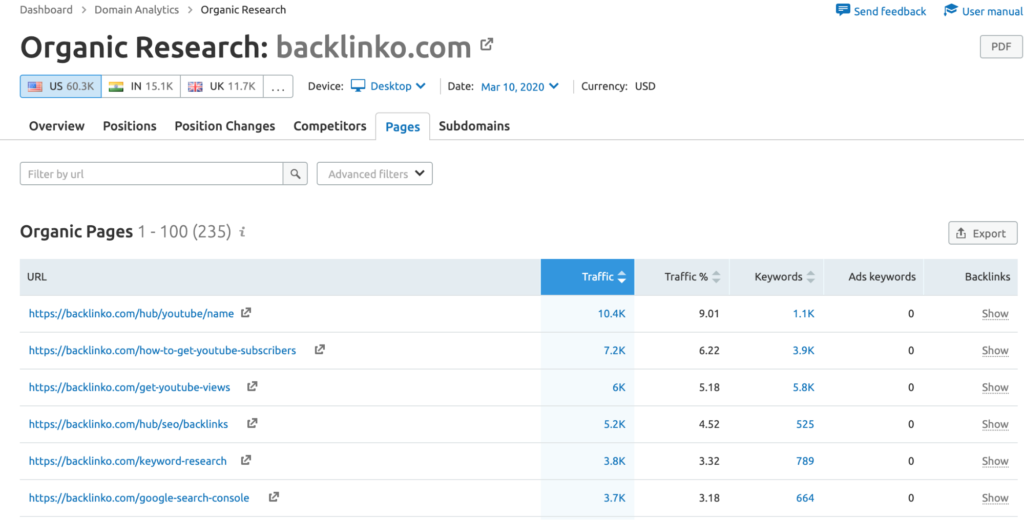
You can also use the Domain Overview report to find additional organic search competitors:

Look at the top pages and even page-level metrics for top content from competitors. Make note of the topics that consistently appear and show strong traffic performance across different competitor sites.
Remember, though: You don’t want to match your competitors. You want to outdo them.
-
Reddit
Reddit won’t give you organic traffic metrics for particular pages. It won’t really give you useful, quantitative data. (If this hurts your little data-driven heart, don’t worry! We’ll get you your data on these topics in the keyword research section.)
What it will give you, though, is aggregated anecdotal insight into what your niche is searching for. Reading subreddits is like being a spy or an anthropologist, compiling and combining observations to build a depth of understanding of your audience and what they’re interested in.
Search for your niche on Reddit, and you’ll immediately get results for related subreddits. Since there are subreddits on virtually every topic, you can easily hone in on specific demographics to see what interests them.
Here, we’ve found at least three related to personal finance:
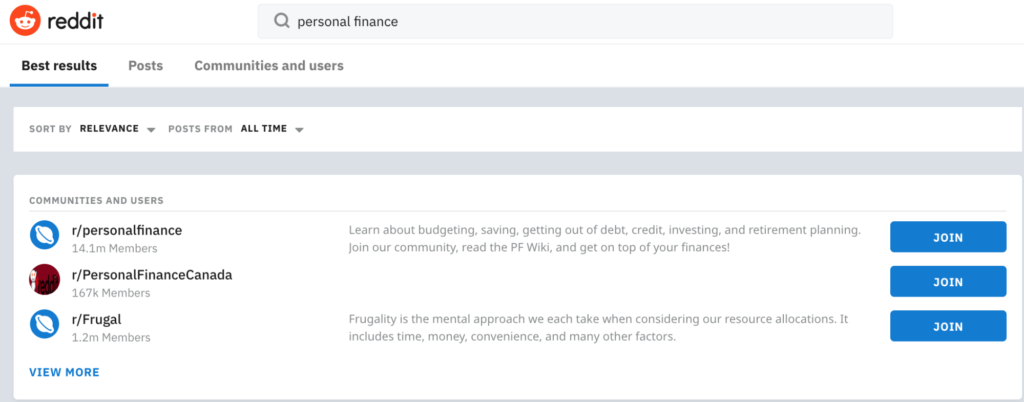
R/personalfinance has over 14 million members, which is an excellent sample size for figuring out what people always want to know about personal finance.
TIP: On your chosen subreddit homepage, be sure to filter posts to “Top” for the year (or all time) to look for evergreen content ideas.
Other filters, like “Hot” or top posts for the day or week, can be great ways to find trending topics for other types of content, but they are unlikely to reveal strong evergreen content topics.
-
Quora
Quora is similar to Reddit in that it consists of question-and-answer and discussion forums centered around specific topics. You can search for key terms in your niche and find both “Topics” and “Spaces” dedicated to it.
In the example below, we can see the available topics and spaces for the term “freelance”:
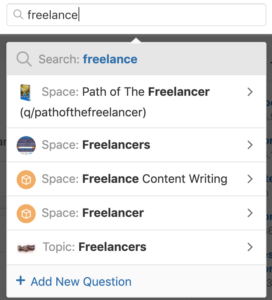
Spaces operate more like subreddits, where you can filter by top posts (although there is no time frame for them). Topics simply group related posts together.
Quora and other fora (!) may not possess the extent of data or filtering capabilities of SEO tools or Reddit, but they still provide a direct connection to your target audience. By monitoring these forums, you can see what topics are consistently up for discussion, and create evergreen content to meet those needs.
Keyword Research
Once you’ve gathered a list of content ideas from your research using the methods above, it’s time to find the right keywords to frame your content and optimize it for SEO. This is where you get that cold, hard data to help you make a decision on your evergreen content.
There are dozens of keyword research tools and methods, but we’ll walk you through some of our favorites.
-
Answer the Public
Answer the Public is best known for generating dozens of question-style keywords grouped according to question modifiers like:
- Who
- What
- When
- Where
- Why
- How
- (and other things you learned in first grade)
Enter your basic topic idea, and in just a few seconds, you’ll have a web of dozens of keywords:
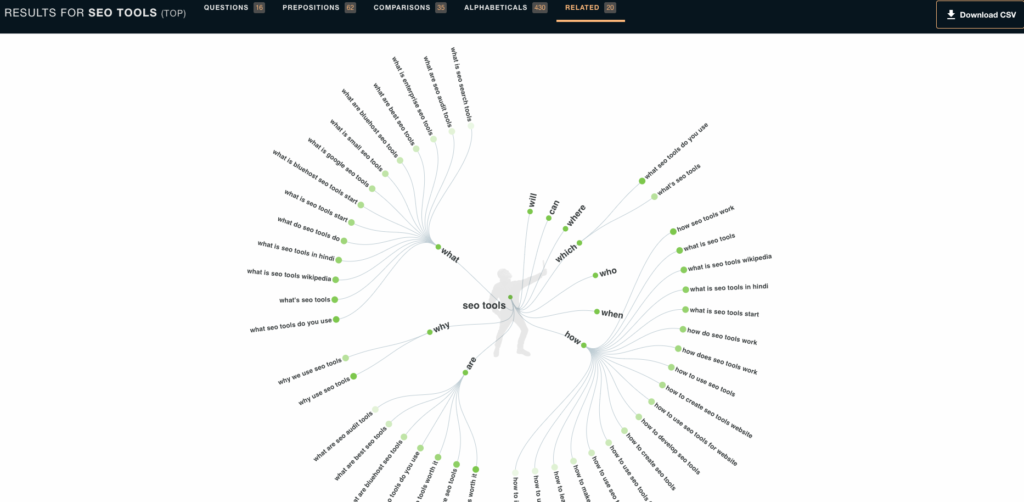
This tool helps you find keywords that explore all facets of a topic, which is really useful for informational content such as “What Is” content or ultimate guides. Using some of these questions as secondary keywords or subheadings to organize your content gives you a head start on your actual content creation.
You can download these results to a CSV and compile a list of keywords from multiple tools to analyze and select the best options.
Note that Answer the Public does not provide search volume data, so if that’s part of your analysis, you’ll need to use an additional tool, such as Google Keyword Planner or Keywords Everywhere, to find that information.
-
SEMrush Keyword Magic Tool
The SEMrush Keyword Magic Tool is a newer feature, but has tons of capabilities that are immensely helpful for keyword research.
After putting in your seed keyword, you’ll see a list of related keywords along with search volume and other metrics. Keywords can be filtered and organized by subsections, exact matches, and more.
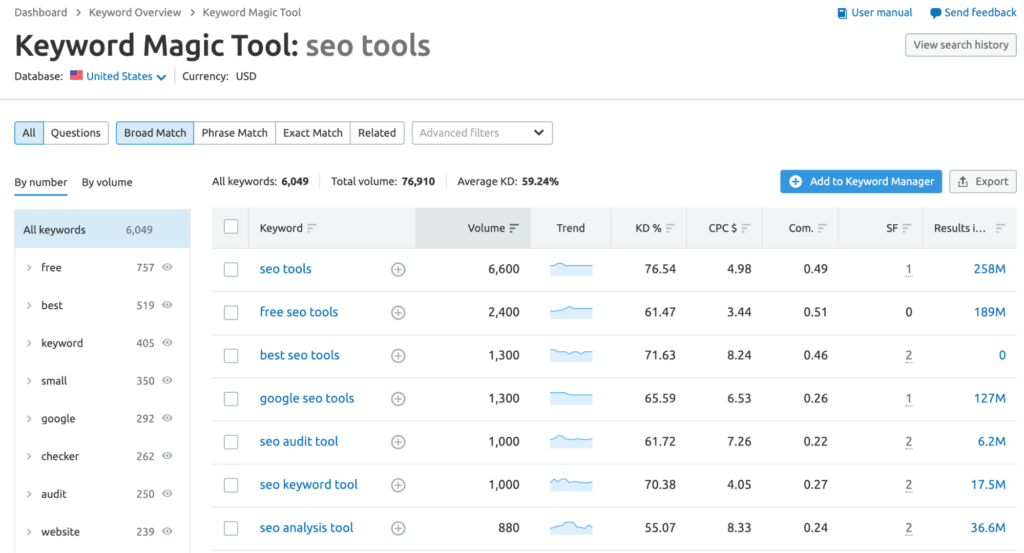
This information can also be exported to a CSV file for additional analysis.
-
Ahrefs Questions
The Ahrefs keyword research tool functions similarly to SEMrush Keyword Magic Tool, but with a slightly different layout. Here, you’ll get a broad overview of metrics for your main keyword, along with a difficulty ranking.
It then provides related keywords grouped by categories like:
- Questions
- Same Terms
- Newly Discovered
Once you’ve compiled keyword data from as many sources as you like, you can use Excel to filter and analyze your keywords. While search volume is an important metric, the highest-ranking search volume terms may not always be the best pick.
When you look at your final keyword list for a topic, you should see results split into two groups:
- higher-volume terms that cover your topic at the broadest level (primary keywords), along with
- lower-volume terms, usually framed as questions, that tackle specific facets of your topic (secondary keywords).
Test Your Ideas To See If They Are Evergreen
If you followed one or all of the content ideation methods above, you should be close to honing in on your final evergreen content topic. A final check on the evergreen nature of a topic is to use Google Trends, which provides a sense of how popular a topic has been over time.
Google Trends is an index, so it doesn’t provide exact metrics like search volume. Instead, it provides a popularity score based on the time frame you’re looking at.
Enter your content topic and adjust the time frame to be at least 12 months. You’ll see a trend chart — a graph that looks something like this:
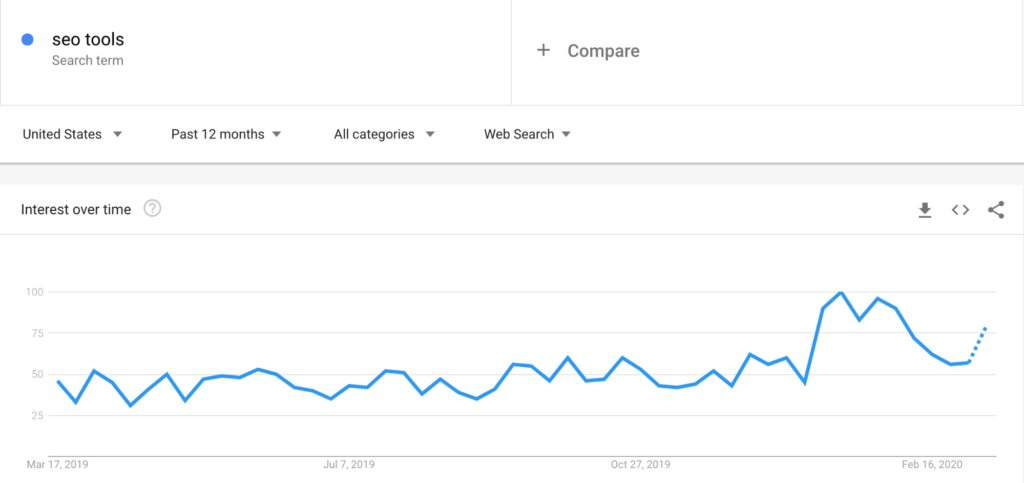
In this example, during the past year, search interest for “SEO tools” was very steady, with a spike in interest at the beginning of the year. This is likely a good topic for evergreen content.
Compare it to this Google Trends graph for “Google algorithm updates”:
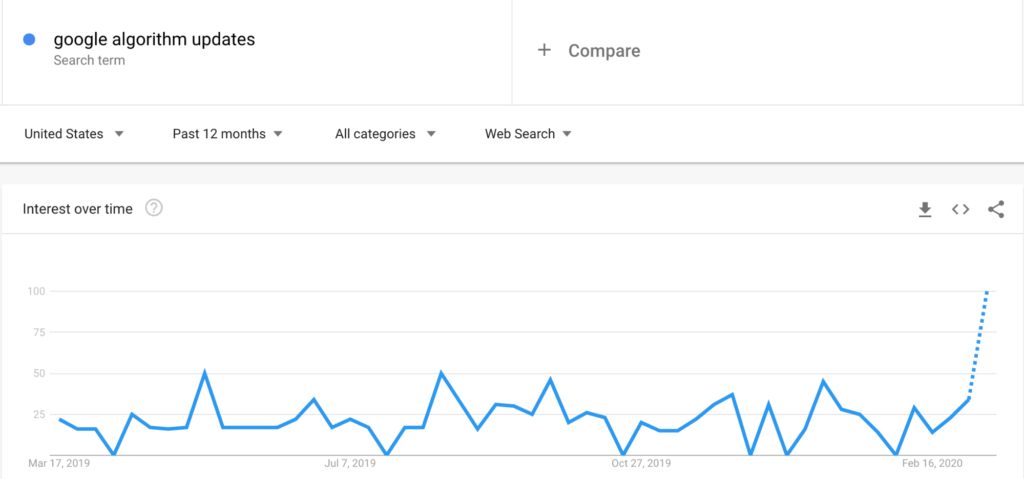
This chart is filled with spikes and valleys, indicating the very seasonal or trending nature of this topic. While this topic may have ongoing relevance at times, it is not a good candidate for evergreen content that will provide a steady flow of organic traffic.
Finally, you want to avoid any topics that are trending downward, like this view of search interest for Vine:
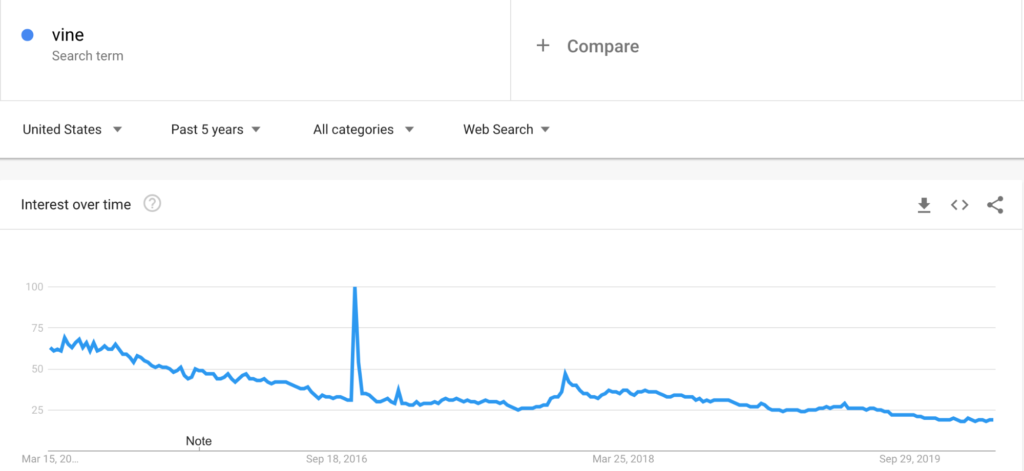
Any evergreen topic should have a trend chart that is consistent in its popularity. A longer upward trend may indicate a perfect topic that will continue to be relevant, but be prepared for that trend to reverse at some point.
Case in point: We all thought the Harry Potter craze would never fade, but the last few years would prove otherwise…
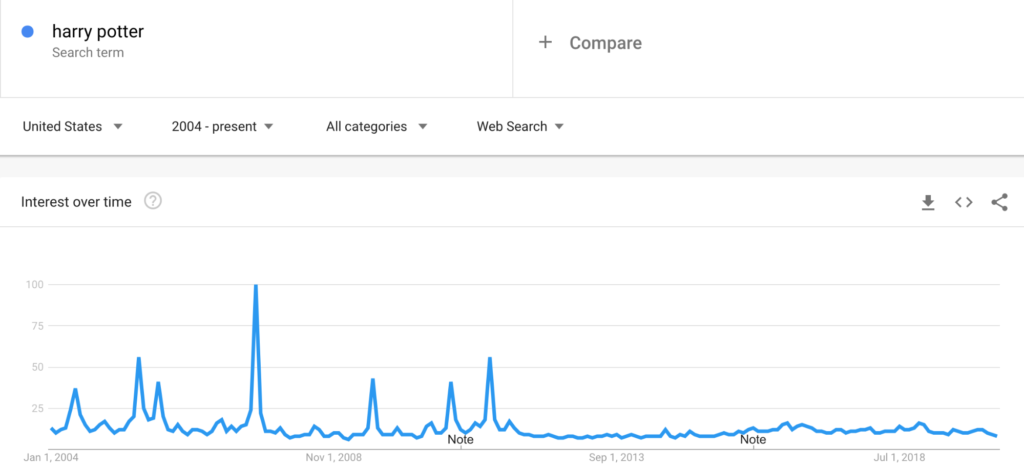
(Granted, this chart covers a roughly 14-year period, so we can certainly forgive Harry for slowing down. But still, the graphs don’t lie.)
Decide Which Idea Is Best
Armed with your list of evergreen content and keyword ideas, it’s time to decide where to start creating.
There are some data points you can use to determine which evergreen topic will best suit your needs, but you’ll also need to make some qualitative decisions (again, so sorry to our data-driven friends).
Here are three factors to consider in determining the best evergreen content idea:
-
Keyword Difficulty Metrics
This handy metric helps you understand how hard it would be to rank for a particular search query. Some keyword difficulty is a good thing: it indicates competition and search interest in your topic. But if a keyword is too difficult to rank for, your investment in creating this content will go to waste.
Both Ahrefs and SEMrush provide keyword difficulty metrics based on search volume, the strength of ranking domains, and other factors. These calculations don’t account for how well your site is positioned among competitors, so you’ll need to have a good understanding of your site’s strengths and weaknesses to properly use this metric.
-
Audience Served, Action Intended
Think carefully about the audience you’re serving with this content and what action you want them to take as a result. If your goal is to improve conversions and demonstrate ROI from your content strategy, select topics that are as close as possible to the action or purchase.
But there is significant value in higher funnel content, as well, so don’t immediately discount these topics. Just make sure you’re prioritizing topics that meet the goals of your overarching strategy.
-
Top Search Results for Your Keywords
If you haven’t done this already, look at the top ten Google search results for your primary keyword. Read through each result and assess the following criteria:
- Is coverage of this topic comprehensive? Where are the holes?
- Is it thoroughly detailed? What did you leave wondering about?
- Could the graphics be better integrated? Did they help express the point?
- Is the content user-friendly? Could it be said or arranged more easily?
These questions help you determine how your content will improve upon what’s already ranking for a keyword. Keep in mind that improving means more than just adding a few hundred more words; you must add real new value to a topic.
If you can’t determine any way that your content will be significantly better than the existing competition, it’s likely not the best idea for evergreen content.
Create Content Worth Reading
When you’re actually creating your content, it’s crucial to keep your reader at the top of your mind. This sounds obvious, but an astonishing number of content marketers write only for search engines, not real people.
What these people miss is that writing for real people actually is writing for search engines. Google’s entire framework is built upon understanding the user’s needs and experience.
Here are some key ways to make content readable, user-friendly, and worthwhile:
- Break up text into sections and use subheadings to help the reader easily find what they are looking for.
- Keep paragraphs and sentences short. Four lines is a good goal for paragraph length.
- Use numbered or bulleted lists for easy reading.
- Avoid jargon. Explain concepts in simple and plain language for anyone to understand.
The text itself isn’t the only aspect of content creation. Pay careful attention to images, as well. While they serve to break up walls of text, they should also provide new information or offer a new angle to assist in educating the reader. Stock images have no place in evergreen content.
Often, the best way to stand out from competitors is to provide a new format or resource that no one else is currently offering. This could be:
- An infographic
- A template
- A downloadable worksheet
- A PowerPoint format of your content
When considering add-ons like these, think editorially. Only add elements that are truly helpful to the reader — you know, the person you’re actually creating this content for!
The longer the post, the more critical you should be about adding even more. Otherwise, you may risk creating content that is too long and complex to be useful, like the terms and conditions that people blindly accept without reading or retaining any of it.
Promote Your Content
Once your evergreen content is finalized, you can’t just hit Publish and wait for the traffic to start rolling in. You need a little content promotion to push it into search results.
Most pieces will need some link authority in order to start ranking, so think about what your outreach campaign might look like throughout the content creation process. You can utilize link building tactics such as:
- Guest posting
- Cold-pitching your new resource
- Traditional PR tactics
Don’t forget to add internal links to your new content, as well!
As you plan your content promotion strategy, be sure to think of your secondary audiences in addition to your primary one. A piece on SEO tools will obviously be targeted to SEOs, but small business owners, freelancers, and copywriters may also find value in it. Include them in your content promotion plans, too.
Evergreen Content Examples
As you start out creating evergreen content, it’s smart to take a look at some examples of content that meets the criteria we’ve outlined in this article.
In this section, we’ve found 12 examples of evergreen content across a variety of industries. We’ll explain what works about each piece of content and ways we think it could be improved.
-
AutoZone: Easy Steps to Change Your Oil
Content type: How To
What’s great about this piece: AutoZone starts with a video showing the entire process from start to finish, then breaks it down into steps with accompanying text and images. The overall effect is one that’s clear and easy to understand.
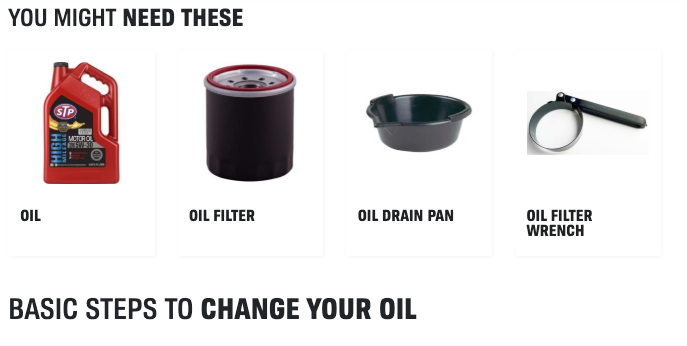
How to improve: The visual supply list is a great touch, but is far from comprehensive. This is a great spot for an interactive or downloadable checklist. (It could even refer readers to a purchase page on the AutoZone site.)
Additionally, some images could be enhanced with arrows or other directional cues for the steps that require motion. The static images bring a lot to this content, but there are still ways to increase comprehension.
-
On the Clock: What Is a Pay Period?
Content type: What Is
Why it works: This piece thoroughly explores all types of pay periods and their respective pros and cons. It also uses data to back up the facts.
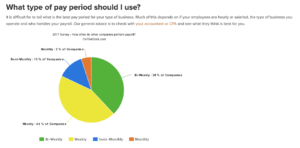
Ways to improve it: From a design standpoint, there are a few things to improve. More images and cleaner formatting could go a long way here. On The Clock attempts to improve UX by including jumplinks to each section, but they’re not intuitive for the user.
-
Moving.com: Move Planner
Content type: Checklist
What works: This moving checklist is both exhaustive and interactive, covering everything from pre-move research to important tasks in your first month post-move. Each line item includes a brief explanation of the task and why it’s important.

As a bonus, you can filter it for the specific week you’re targeting, or print it out to keep handy around the house.
Ways to improve: Moving checklists aren’t entirely unique, so a real value-add to this piece would be to provide a way to input your moving date and automatically calculate deadlines for accomplishing each task.
-
TemplateLab: 47 Printable Daily Planner Templates
Content type: List / templates
What’s great about this content: This page does an excellent job of covering every aspect of the topic at hand. The template offerings are varied and provide bright imagery, while the table of contents includes functioning jumplinks to direct readers to different sections.
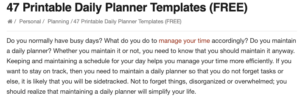
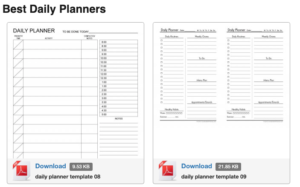
Room for improvement: Honestly, there’s not much to improve here. Since it includes a “trending” section, the site owners should be sure to update that regularly, but other than that, this piece has all the hallmarks of stellar evergreen content.
-
The Strong National Museum of Play: Video Game History Timeline
Content type: History of a Topic
What’s great about it: This timeline is truly exhaustive, with entries dating back to the 1940s. You can navigate through the decades using the simple top navigation. Each entry is accompanied by images of relevant artifacts from the museum’s collections, creating a strong visual impact.
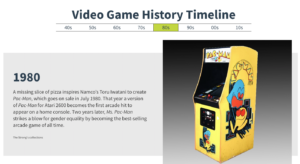
How to improve: Each entry is fairly short, so additional information on each item could really bring this content to the next level.
Also, since this content comes from a museum, based on their own archives, there is little linking to other resources. Linking to companies or games that are mentioned or other primary sources would provide a lot of additional value for people interested in this topic.
-
The Spruce Eats: Quick, Kid-Friendly Dinner Recipes
Content type: List
Why it’s great: This list includes 54 recipes, all accompanied by high-quality images. It’s a great internal linking play as well, as each recipe is connected to at least one other page on the site.

How it could be better: The descriptions of each recipe are short, and there’s no real rhyme or reason given for why each recipe was picked. Fleshing out each entry with prep and cook times, servings, calories, and star rating would be simple value-adds, as these metrics are all available elsewhere on the site already.
For extra appeal to busy parents, a metric counting the number of ingredients and rating the difficulty level would make using this list even easier.
-
Inc.com: Expert Leadership Tips
Content type: List
What’s great about it: This article features rich quotes from leaders across industries, and they all speak to near-universal truths about leadership. It’s unlikely this content will become obsolete anytime soon.
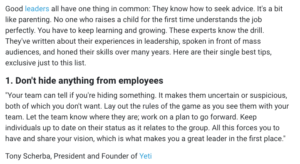
Additionally, by quoting and linking to numerous experts, some content promotion is already secure. These leaders are likely to share and link to this article from their own websites and social media, exposing it to their audiences and increasing your impact.
Room for improvement: Categorizing these quotes by leadership topic (such as communication or accountability) could make this content easier for readers to skim and navigate.
Having more context on these leaders, like their backgrounds and how they were chosen to weigh in on this article, would also give a bit more for readers to chew on.
-
Zoosk: Dating Profile Examples
Content type: Examples
What Works: This article features dating profile examples from several popular apps and portrays diverse, pretty people in their profiles. Where some might compile a list of examples and leave it at that, this content includes explanations of the nuances of creating a profile on each app. It also links to further reading on tips for each app.

What doesn’t work: There’s no section for general tips on dating app etiquette, which would round out this topic nicely. Similarly, a bulleted list of Dos and Don’ts for each app profile could make this piece a bit more readable.
-
ThriveTalk: What Is Gaslighting?
Content type: What Is
Why this piece is great: This content smoothly and easily explains a complex and heavy topic related to emotional abuse. It makes great use of formatting, with headings, subheadings, and both numbered and bulleted lists.
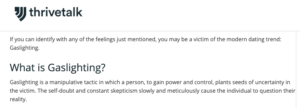
How to improve: Although the formatting is excellent and the copy clear and concise, the lack of imagery makes this page feel a bit boring. Custom images, perhaps in comic strip form, showing examples of gaslighting in action, could take this piece to the next level. Alternatively, example stories or videos could provide this extra insight.
-
Expert Photography: A Beginner’s Guide to Photography
Content type: Ultimate guide
What’s great about it: This beginner’s guide provides a clear and concise introduction to a complex subject that requires a lot of expertise and attention to detail. The photo examples to demonstrate each principle are stunning, and extra design assets like infographics and charts allow additional comprehension.
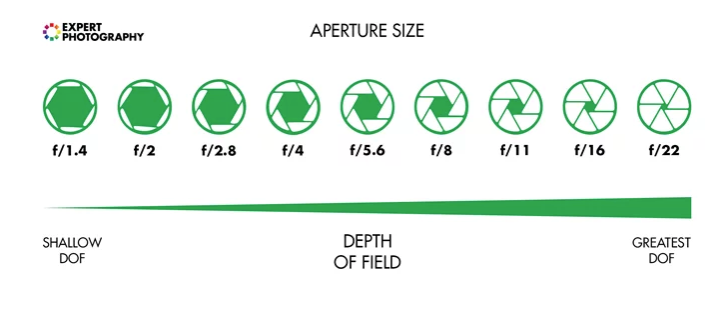
Another great element is that the subheadings for each concept double as links to additional information on the topic. While there may be some risk of users confusing these for jumplinks, the compilation of resources is unparalleled.
How to improve: One feature that a lower-ranking competitor of this page (found here) includes is side-by-side comparisons of each feature used correctly and incorrectly. This serves as an additional guide for users to know if they are doing it right, and would be an excellent value-add to a guide.
-
CNET: Marvel Movie Timeline
Content type: History of a Topic
What we like: The timeline graphic clearly and simply lays out the complex timeline of the Marvel Cinematic Universe. It also answers common questions and objections about the placement and interaction of certain movies or shows within the timeline, showing an anticipation of the audience’s needs.
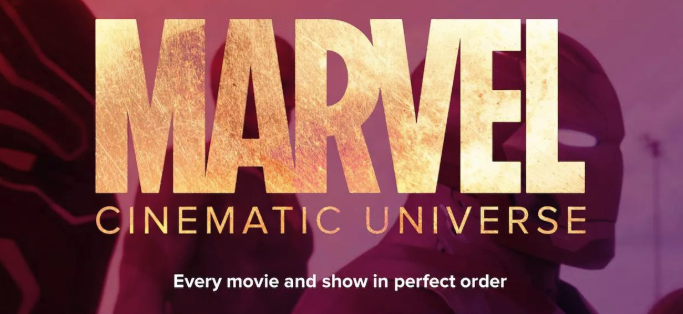
It’s also a great example of how evergreen content must be updated regularly: Since the timeline was first published in 2015, it has been updated 47 times to remain relevant.
Ways to improve: There’s very little information about each entry in the timeline. Including run times and where to watch each movie or show would preserve the overall design while providing that little bit of extra information to make this timeline even more useful.
-
Complex: Game of Thrones Glossary
Content type: Glossary
What’s great about it: This piece uses a single-page glossary to explain a complex topic. Because the Game of Thrones universe is so extensive, this is an excellent reference for both new and longtime fans of the show. It gives an animated design for each letter in an appropriately medieval style, which adds some visual interest, and a clickable alphabet across the top providing jumplinks to each letter.

What could improve: Many glossaries use multiple pages and take advantage of cross-linking between them — for example, a page for Tywin Lannister that links to each of his children. This could make the information more digestible and easier to navigate for the reader, especially for a topic with so many families and personal interactions involved.
Another note is that this is the kind of evergreen content that fades out of being evergreen. While Game of Thrones is still a huge part of our cultural vernacular, the conclusion of the series has likely led to a drop in traffic to this page.
How to Make Any Piece of Content Evergreen
Sometimes, you have that perfect topic that you just know will draw tons of organic traffic — but it’s just not quite evergreen. Maybe there’s a dazzling statistic or a truly innovative trend that you just have to talk about. How can you convert that topic into something that will last beyond the initial interest?
The two most common non-evergreen topics that marketers desperately want to make evergreen (in fact, you might say they “pine” for it!) are data and statistics and trending topics. Here are some ways you can convert those content ideas into something that will last:
Data and Statistics
As we discussed earlier, data and stats are not evergreen because their relevance fades as new studies are conducted. Most writers and researchers don’t want to cite statistics that are older than three years old, and anything more than five years old is likely considered obsolete.
But if you’re committed to regularly updating your data, creating a central page for all your industry statistics can be an immensely valuable piece of evergreen content. This could even list historic or outdated statistics in a trend chart so visitors can see how a metric has changed over time.
Data-based evergreen content also depends largely on the approach and structure of a page. A page centered around car accident statistics can be easily refreshed with the latest data, but an article outlining a 2020 study on America’s most dangerous highways will be much harder to refresh.
Trends
Trending topics can be tricky to convert to evergreen topics. Humans are a fickle lot, so there’s just no way to predict how even the broadest trends will look in a few weeks or months.
One way to make trending topics more evergreen is to create a trends page that is regularly updated to include the latest trends. This page can link out to other non-evergreen content that’s also related to the trend.
Another option is to take a historical view of all relevant industry trends. For example, if you wanted to create content around TikTok, you could instead create a page about social media video platforms. It would feature TikTok as the current trend, but look at Vine, Snapchat, and YouTube as other forms of social video. As trends change, this page would be updated to reflect that.
Almost any viable topic can become evergreen with a little creative thinking. Take a big-picture view and look at which element of your idea is consistently relevant, and build your content around that idea.
Conclusion
Evergreen content is a crucial part of any content marketing strategy. It forms a consistent base on which other content can be built, and it builds a steady stream of organic traffic.
To find great evergreen content, you must push past trending topics and what’s hot right now to look for the content that will always answer an important question for your audience. Create resources, templates, and images that enhance your audience’s understanding of a topic in ways a simple blog post never could.
Investment in a single piece of evergreen content can bring in organic traffic for years to come, and other content on your site will benefit from the strength of this piece. Evergreen content is truly the gift that keeps on giving.
